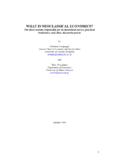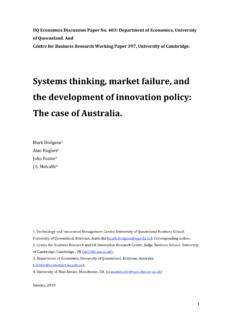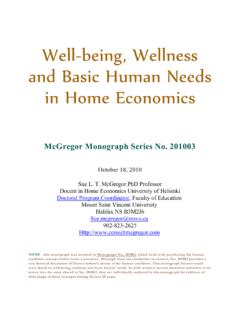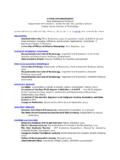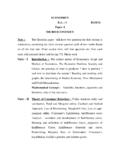Transcription of THE ECONOMICS OF PATIENT SAFETY - oecd.org
1 THE ECONOMICS OF. PATIENT SAFETY . Strengthening a value-based approach to reducing PATIENT harm at national level Luke Slawomirski, Ane Auraaen and Niek Klazinga MARCH 2017. ACKNOWLEDGEMENTS. The work presented here was undertaken by the OECD to provide a background report for the 2nd Global Ministerial Summit on PATIENT SAFETY in Bonn, March 2017. The work was enabled by a voluntary contribution from the Ministry of Health of Germany (BMG). The authors would especially like to acknowledge Dr Ingo H rtel for his input and support. The authors would like to thank the academic experts who responded to the snapshot survey: Professor Don Berwick; Professor Jeffrey Braithwaite and Dr Virginia Mumford; Lord Ara Darzi.
2 A/Professor Martine de Bruijne; Professor Liam Donaldson; Professor Philippe Michel and Professor Ren Amalberti; Professor Bill Runciman; and Professor Charles Vincent. We are also grateful to the policy experts from the following countries for their responses to the snapshot survey: Australia, Belgium, Canada, Czech Republic, France, Israel, Japan, Latvia, Luxemburg, Norway, Poland, Slovak Republic, Spain, Sweden and Switzerland. Within the OECD Health Division we are very grateful to Ian Brownwood for the valuable input and suggestions. We would also like to thank Francesca Colombo, Nick Tomlinson and Michael M ller for their feedback and support, and Fr d ric Daniel for assistance with data analysis.
3 THE ECONOMICS OF PATIENT SAFETY OECD 2017 3. March 2017. TABLE OF CONTENTS. KEY MESSAGES ..5. INTRODUCTION ..5. SECTION I: THE COST OF FAILURE ..9. PATIENT harm exerts a high public health burden worldwide ..10. 1. 2 Financial and resource costs of PATIENT harm are high ..14. Condition- and event-specific costs are considerable ..16. The overall financial impact of adverse events constitutes a large proportion of expenditure ..18. The costs of PATIENT harm are underestimated and spill over beyond healthcare systems ..20. Much of the cost can and should be The costs of harm dwarf the costs of preventing it ..22. National efforts to reduce harm and improve SAFETY can deliver considerable SECTION II: REDUCING HARM EFFECTIVELY AND The causes of harm - and strategies to minimise it.
4 27. PATIENT SAFETY culture and a systems perspective are important ..28. Structures, processes and end-point delivery practices determine success or failure ..29. A value-based approach to improving PATIENT SAFETY across healthcare systems ..30. Clinical-level interventions targeting burdensome adverse events received the most favourable ratings33. The highest-rated interventions are backed by sound empirical There were some notable omissions ..37. However, the need for prioritisation elevated the importance of system- and organisational-level interventions ..38. Associations among key best buy' interventions were identified ..41. Workforce education, training and socialisation are fundamental.
5 43. A PATIENT SAFETY culture is critical ..44. A value based approach to SAFETY targets all levels of the healthcare system ..45. CONCLUSION ..47. REFERENCES ..49. ANNEX 1. SNAPSHOT SURVEY DESIGN AND METHOD ..55. ANNEX 2. SURVEY RESULTS ..62. THE ECONOMICS OF PATIENT SAFETY OECD 2017 4. KEY MESSAGES. PATIENT SAFETY is a critical policy issue. PATIENT harm has been part of health care for as long as health care has been practised. The extent of it has been measured and quantified more systematically in recent times, leading to calls for more leadership and action. PATIENT harm is estimated to be the 14th leading cause of the global disease burden. This is comparable to diseases such as tuberculosis and malaria.
6 In some OECD. countries, the burden of PATIENT harm is similar to that of chronic diseases such as multiple sclerosis and some types of cancer. The cost to patients, healthcare systems and societies is considerable. PATIENT harm imparts a high financial cost. Overall, the available evidence suggests that 15% of hospital expenditure and activity in OECD countries can be attributed to treating SAFETY failures. This is likely to be a conservative figure. PATIENT harm is felt in the broader economy through lost capacity and productivity of patients and their carers. It is estimated that the aggregate costs amount to trillions of dollars each year. In the political economy, the cost of SAFETY failure includes loss of trust in the health systems, in governments and in social institutions.
7 Most of the burden is associated with a few common adverse events. The most burdensome include healthcare-associated infections (HAI), venous thromboembolism (VTE), pressure ulcers, medication error and wrong or delayed diagnosis. For example, it is estimated that every adult in the United States will experience a diagnostic error at least once during their life time. The annual cost of common adverse events in England is equivalent to 2,000 GPs or 3,500 hospital nurses. Greater investment in prevention is justified. Many adverse events can be systematically prevented through better policy and practice, with the cost of prevention typically much lower than the cost of harm. HAI or VTE prevention programs, for example, cost a fraction of the financial burden these events impart.
8 It is estimated that in the United States USD 28 Billion has been saved between 2010 and 2015 by systematically improving SAFETY . Solid foundations for PATIENT SAFETY need to be in place. A hierarchy of programs and interventions to improve SAFETY exists. A national value-based approach - where harm is reduced using limited resources - should begin with investing in fundamental system-level initiatives such as professional education and training, SAFETY standards and a solid information infrastructure. Active engagement of providers and patients is critical. Organisational-level initiatives such as clinical governance frameworks, PATIENT engagement and building a positive SAFETY culture also form an important part of an integrated PATIENT SAFETY strategy.
9 Innovation at the clinical level is enhanced through national leadership. With these structural reforms in place, micro-level interventions to prevent specific adverse event types at the clinical practice level can be implemented to minimise harm. Emphasis should broaden from SAFETY in hospital settings to primary care and long term care. Vision and leadership at the highest levels of government is required to operationalise a systems approach to improving PATIENT SAFETY and ensure that healthcare is a high-reliability industry. Practical approaches exist to identify national priorities for action. A system-wide priority setting exercise with broad range of stakeholders can build consensus and inform SAFETY strategies to reduce PATIENT harm, releasing scarce resources to improve population health and wellbeing.
10 THE ECONOMICS OF PATIENT SAFETY OECD 2017 5. INTRODUCTION. 1. A principal responsibility of healthcare providers, facilities and systems is to do no harm', and do everything to ensure that the benefits of an intervention outweigh its risks and deleterious effects. But harmful adverse events1 have been a feature of health care throughout history. Starr (1982) reports that in the 19th century [h]ospitals were regarded with dread, and rightly so. They were dangerous places; when sick, people were safer at home ( ). Subsequently, as medical technology advanced and the status and authority of medicine and health care grew, it was increasingly assumed that care was safe (Berwick 2016).










